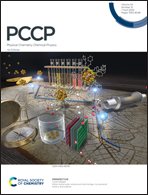Tuning the edge states in X-type carbon based molecules for applications in nonlinear optics†
Abstract
Novel carbon based “X-type” graphene nanoribbons (GNRs) with azulenes were designed for applications in nonlinear optics in the present work, and the second order nonlinear optical (NLO) properties of those X-type GNRs were predicted using the sum-over-states (SOS) model. The GNRs with edge states are feasibly polarized. The effects of zigzag edges on the NLO properties of GNRs are scrutinized by passivation, and the electronic structures of GNRs are modulated with heteroatoms at the zigzag edges for improved stability and NLO properties. Those nanomaterials were further functionalized with electron-donating and electron-withdrawing groups (NH2/NO2) to enhance the NLO responses, and the connection of those functional groups at the azulene ends play a determinant role in the enhancement of the NLO properties of those X-type nanoribbons, e.g., the static first hyperpolarizability (〈β0〉) changes from −783.23 × 10−30 esu to −1421.98 × 10−30 esu. The mechanism of such an enhancement has been investigated. Through two-dimensional second order NLO spectra simulations, particularly besides the strong electro-optical Pockels effect and optical rectification responses, strong electronic sum frequency generations and difference frequency generations are observed in those GNRs. The strong second order NLO responses of those GNRs in the visible light region bring about potential applications of these carbon nanomaterials in nonlinear nanophotonic devices and biological nonlinear optics.



 Please wait while we load your content...
Please wait while we load your content...